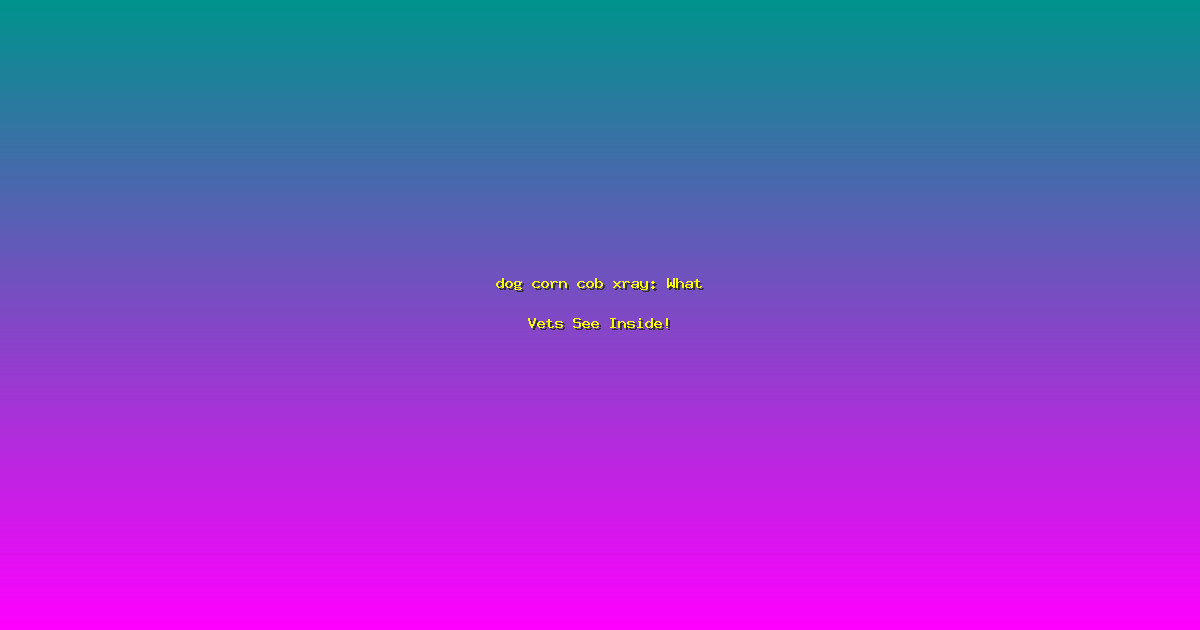dog corn cob xray: What Vets See Inside!
Imagine the panic that sets in when you realize your beloved pet has swallowed a corn cob. It’s a common scenario, especially during the summer months when corn on the cob is a staple at barbecues. But what happens next? A dog corn cob xray can reveal the extent of the problem and guide the necessary treatment. This article will explore the dangers of corn cobs, the diagnostic process, and how to prevent this potentially life-threatening situation. Let’s dive into the world of veterinary diagnostics and learn how to keep your furry friend safe.
The Dangers of Corn Cobs for Dogs
While corn on the cob is a delicious treat for humans, it can be a dangerous snack for dogs. Corn cobs are not digestible and can cause severe blockages in a dog’s digestive tract. According to the American Kennel Club, corn cobs are one of the most common foreign objects ingested by dogs, leading to emergency vet visits. The hard, cylindrical shape of the corn cob can get lodged in the stomach or intestines, causing obstruction and potentially life-threatening complications.
- Blockages: Corn cobs can cause blockages in the stomach or intestines, leading to severe pain and discomfort.
- Intestinal Perforation: In severe cases, the sharp edges of the corn cob can perforate the intestinal wall, leading to peritonitis, a serious infection of the abdominal cavity.
- Emergency Surgery: If a corn cob is not removed promptly, it may require emergency surgery to prevent fatal complications.
The Diagnostic Process: Understanding the Dog Corn Cob Xray
When a dog ingests a corn cob, a dog corn cob xray is often the first step in diagnosing the problem. X-rays can reveal the location and size of the corn cob, helping veterinarians determine the best course of action. The x-ray image will show the corn cob as a dense, cylindrical object, clearly visible against the softer tissues of the digestive tract.
- Diagnostic Imaging: X-rays are a non-invasive way to visualize the corn cob’s location and assess the severity of the blockage.
- Ultrasound: In some cases, an ultrasound may be used to get a more detailed view of the digestive tract and the corn cob’s position.
- Actionable Insights: The x-ray results help veterinarians decide whether to proceed with surgery or attempt to remove the corn cob through other means.
Prevention and Treatment: Keeping Your Dog Safe
Preventing your dog from accessing corn cobs is the best way to avoid the need for a dog corn cob xray. However, if your dog does ingest a corn cob, prompt action is crucial. Early detection and treatment can prevent serious complications. Here are some tips to keep your dog safe:
- Supervision: Keep an eye on your dog during outdoor activities and ensure they don’t have access to corn cobs.
- Training: Train your dog to avoid eating non-food items, including corn cobs.
- Immediate Action: If you suspect your dog has ingested a corn cob, contact your veterinarian immediately. Early intervention can prevent the need for surgery and reduce the risk of complications.
Frequently Asked Questions
What are the signs that my dog has ingested a corn cob?
Signs of corn cob ingestion include vomiting, loss of appetite, lethargy, and abdominal pain. If you notice any of these symptoms, especially after a barbecue or picnic, it’s crucial to seek veterinary care immediately.
How does a dog corn cob xray work?
A dog corn cob xray uses low-dose radiation to create an image of the dog’s internal organs. The dense material of the corn cob will appear clearly on the x-ray, allowing veterinarians to assess the situation and plan the appropriate treatment.
What happens if my dog needs surgery to remove a corn cob?
If the corn cob is causing a blockage that cannot be resolved through non-surgical means, your veterinarian may recommend surgery. The procedure involves making an incision in the abdomen to remove the corn cob and repair any damage to the digestive tract.
Can corn cobs cause long-term damage?
Yes, if left untreated, corn cobs can cause long-term damage to the digestive system, including chronic inflammation and scarring. Early detection and treatment are crucial to prevent these complications.
Are there any home remedies for corn cob ingestion?
There are no home remedies for corn cob ingestion. If you suspect your dog has ingested a corn cob, it’s essential to seek professional veterinary care immediately. Attempting to treat the issue at home can lead to serious complications.
Conclusion
A dog corn cob xray is a critical tool in diagnosing and treating this common but dangerous situation. By understanding the risks and knowing the signs of corn cob ingestion, you can take swift action to protect your pet. Remember, prevention is key, so keep corn cobs out of reach and supervise your dog during outdoor activities. If you suspect your dog has ingested a corn cob, don’t hesitate to contact your veterinarian. Your quick response could save your pet’s life.
